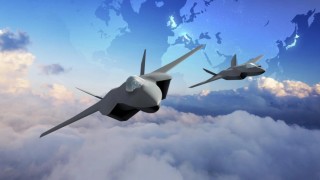Loading
Search
▼ New UK-Japan-Italy Fighter Takes Shape, With Electronics Details Emerging
- Category:Other
“More than half the things this aircraft can do is because of its sensors,” said Masahiko Arai, Senior General Manager, Defense Systems Division, Mitsubishi Electric.
Last week’s DSEI Japan show served as a showcase for the Global Combat Air Program (GCAP), with government and industry representatives from Italy, Japan and the United Kingdom gathering to announce new technology partnerships for the sixth-generation fighter.
GCAP took center stage at the exhibition in Tokyo with a scale model of the technology demonstrator flanked by industrial partners promoting advanced electronics, weapon systems and propulsion solutions.
The program was enough of a draw for the defense ministers from the UK and Italy to travel from Europe for the event.
Following a tri-lateral ministerial meeting with his Italian and Japanese counterparts at the exhibition, UK defense secretary Ben Wallace said “The GCAP is an enduring, strategic, partnership that will see the creation of a sixth-generation fighter, to protect our skies for decades to come and bring together an alliance of nations, bridging Europe and the Pacific.”
Maj. Gen. Masaki Oyama, Japan’s Acquisition, Technology & Logistics Agency’s Director Development Division GCAP, described the project as “symbolic of a system of systems approach to a sixth-generation aircraft.”
He also highlighted the importance of “freedom of action” and “freedom of modification” for the partner nations which would enable them to deal with emerging threats and new technologies in 2035 and beyond.
The event saw prime contractors BAE Systems, MHI and Leonardo agree to “work closely together on the next steps” on the program, which is supposed to deliver a fighter by 2035 (what those “next steps” may be remains unclear).
Meanwhile, engine contractors Rolls-Royce, IHI and Avio Aero agreed to pool expertise on design, manufacture and testing for the fighter’s future engine.
Meanwhile, MBDA UK was at the show promoting Meteor and Spear EW weapon systems — both of which are set to be carried by Royal Air Force F-35 Joint Strike Fighters.
Once in service, it is expected these weapon systems will be made available for the GCAP, supported by multi-national partners in the consortium.
Relatively more concrete in terms of detail was a new collaborative agreement signed by Mitsubishi Electric, Leonardo UK, Leonardo and ELT to develop advanced on-board electronics for GCAP, referred to as the Integrated Sensing and Non Kinetic Effects (ISANKE) and Integrated Communications Systems (ICS).
According to a joint press release published on March 15, ISANKE will comprise a “fully integrated sensing, fusion and self-protection capability that draws on a spider’s web of sensing and effecting nodes across each platform.” ICS, the statement added, will enable ISANKE to operate as a “network across formations of crewed and uncrewed aircraft, as part of each nations’ wider, multi-domain system-of-systems.”
“GCAP will play a key role in gaining air superiority,” Oyama said, while referencing contemporary and future operating environments where vast amounts of information are shared across the battle space.
“For pilots, ISANKE/ICS will be ideal if the aircraft moves like part of [their] body. ISANKE and ICS can deliver integrated information of sensors situated across an aircraft ensuring freedom of maneuver while maintaining excellent situation awareness.”
According to Masahiko Arai, Senior General Manager, Defense Systems Division, Mitsubishi Electric, the collaborative agreement will create the appropriate commercial and international operating models required to successfully execute the next stage of GCAP.
The company had already been involved in generating advanced electronics for Japan’s indigenous FX next-generation fighter program, which has been merged into the tri-national effort.
“ISANKE and ICS are GCAP’s advanced electronics, designed to deliver substantially better situation awareness to the pilot, telling them what is going on around them and turning that into information that they can exploit much, much quicker than the adversary,” he explained.
He said ISANKE/ICS would comprise 25 percent of GCAP expenditure but provide more than 50% of the solution’s overall capability.
He compared this to legacy aircraft where electronics would account for between 10 and 15 percent cost and capability.
“More than half the things this aircraft can do is because of its sensors,” he added.
Arai also highlighted how GCAP will improve Japan’s military capability, technology injections and defense industrial base, allowing the country to upgrade and manufacture the air frame domestically.
“The next-gen GCAP will provide opportunities for our next generation of highly qualified engineers and there will spill-over benefits including investment in research and defense which will generate benefits for the wider economy, as well as cooperation with academia and SMEs,” he concluded.
His comments hint at the reality that will have to be dealt with for as long as GCAP is underway: that each country is as invested in the program for its domestic economic benefits as for its defense value.
Leonardo UK’s Andrew Howard, Director, Future Combat Air/GCAP UK, said the agreement would “ensure the technological solution and consider work allocation” across various nations — an issue that will be vital to GCAP, given the native industries will all want a piece of the pie.
“We are exploring [the] extent to which future phases would be based upon a more formal joint venture to deliver capability which is likely to increase cohesion between the companies,” he added.
Leonardo’s Senior Vice President for Airborne Systems, Luca Piccolo said the agreement would allow the industry partners to forge “a closer business arrangement to enable GCAP…. We will move towards something that will be more like a joint venture and in a couple of years, we should have a permanent JV in place,” he suggested.
Speaking to Breaking Defense, ELT’s vice president for global sales and business development, Giovanni Zoccali, confirmed work is already being undertaken as part of the collaboration agreement but would not be drawn on specific efforts.
“Try to imagine what could be the future in technology based on our lessons learned and our history,” he hinted.
- March 22, 2023
- Comment (0)
- Trackback(0)


